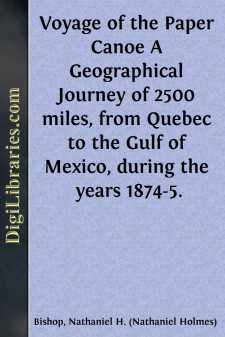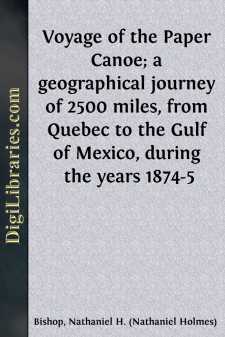Categories
- Antiques & Collectibles 13
- Architecture 36
- Art 48
- Bibles 22
- Biography & Autobiography 813
- Body, Mind & Spirit 142
- Business & Economics 28
- Children's Books 17
- Children's Fiction 14
- Computers 4
- Cooking 94
- Crafts & Hobbies 4
- Drama 346
- Education 46
- Family & Relationships 57
- Fiction 11829
- Games 19
- Gardening 17
- Health & Fitness 34
- History 1377
- House & Home 1
- Humor 147
- Juvenile Fiction 1873
- Juvenile Nonfiction 202
- Language Arts & Disciplines 88
- Law 16
- Literary Collections 686
- Literary Criticism 179
- Mathematics 13
- Medical 41
- Music 40
- Nature 179
- Non-Classifiable 1768
- Performing Arts 7
- Periodicals 1453
- Philosophy 64
- Photography 2
- Poetry 896
- Political Science 203
- Psychology 42
- Reference 154
- Religion 513
- Science 126
- Self-Help 84
- Social Science 81
- Sports & Recreation 34
- Study Aids 3
- Technology & Engineering 59
- Transportation 23
- Travel 463
- True Crime 29
Voyage of the Paper Canoe A Geographical Journey of 2500 miles, from Quebec to the Gulf of Mexico, during the years 1874-5.
Description:
Excerpt
INTRODUCTION.
The author left Quebec, Dominion of Canada, July 4, 1874, with a single assistant, in a wooden canoe eighteen feet in length, bound for the Gulf of Mexico. It was his intention to follow the natural and artificial connecting watercourses of the continent in the most direct line southward to the gulf coast of Florida, making portages as seldom as possible, to show how few were the interruptions to a continuous water-way for vessels of light draught, from the chilly, foggy, and rocky regions of the Gulf of St. Lawrence in the north, to the semi-tropical waters of the great Southern Sea, the waves of which beat upon the sandy shores of the southernmost United States. Having proceeded about four hundred miles upon his voyage, the author reached Troy, on the Hudson River, New York state, where for several years E. Waters & Sons had been perfecting the construction of paper boats.
The advantages in using a boat of only fifty-eight pounds weight, the strength and durability of which had been well and satisfactorily tested, could not be questioned, and the author dismissed his assistant, and "paddled his own canoe" about two thousand miles to the end of the journey. Though frequently lost in the labyrinth of creeks and marshes which skirt the southern coast of his country, the author's difficulties were greatly lessened by the use of the valuable and elaborate charts of the United States Coast Survey Bureau, to the faithful executers of which he desires to give unqualified and grateful praise.
To an unknown wanderer among the creeks, rivers, and sounds of the coast, the courteous treatment of the Southern people was most gratifying. The author can only add to this expression an extract from his reply to the address of the Mayor of St. Mary's, Georgia, which city honored him with an ovation and presentation of flags after the completion of his voyage:
"Since my little paper canoe entered southern waters upon her geographical errand,—from the capes of the Delaware to your beautiful St. Mary's,—I have been deeply sensible of the value of Southern hospitality. The oystermen and fishermen living along the lonely beaches of the eastern shore of Maryland and Virginia; the surfmen and light-house keepers of Albemarle, Pamplico, and Core sounds, in North Carolina; the ground-nut planters who inhabit the uplands that skirt the network of creeks, marshes, ponds, and sounds from Bogue Inlet to Cape Fear; the piny-woods people, lumbermen, and turpentine distillers on the little bluffs that jut into the fastnesses of the great swamps of the crooked Waccamaw River; the representatives of the once powerful rice-planting aristocracy of the Santee and Peedee rivers; the colored men of the beautiful sea-islands along the coast of Georgia; the Floridians living between the St. Mary's River and the Suwanee—the wild river of song; the islanders on the Gulf of Mexico where I terminated my long journey;—all have contributed to make the 'Voyage of the Paper Canoe' a success."
After returning from this paper-canoe voyage, the author embarked alone, December 2, 1875, in a cedar duck-boat twelve feet in length, from the head of the Ohio River, at Pittsburgh, Pennsylvania, and followed the Ohio and Mississippi rivers over two thousand miles to New Orleans, where he made a portage through that city eastwardly to Lake Pontchartrain, and rowed along the shores of the Gulf of Mexico six or seven hundred miles, to Cedar Keys, Florida, the terminus of his paper-canoe voyage.
While on these two voyages, the author rowed over five thousand miles, meeting with but one accident, the overturning of his canoe in Delaware Bay. He returned to his home with his boats in good condition, and his note-books, charts, &c., in an excellent state of preservation.
At the request of the "Board on behalf of the United States Executive Department" of the Centennial Exhibition at Philadelphia, the paper canoe "Maria Theresa," and the cedar duck-boat "Centennial Republic," were deposited in the Smithsonian Department of the United States Government building, during the summer and fall of 1876....



